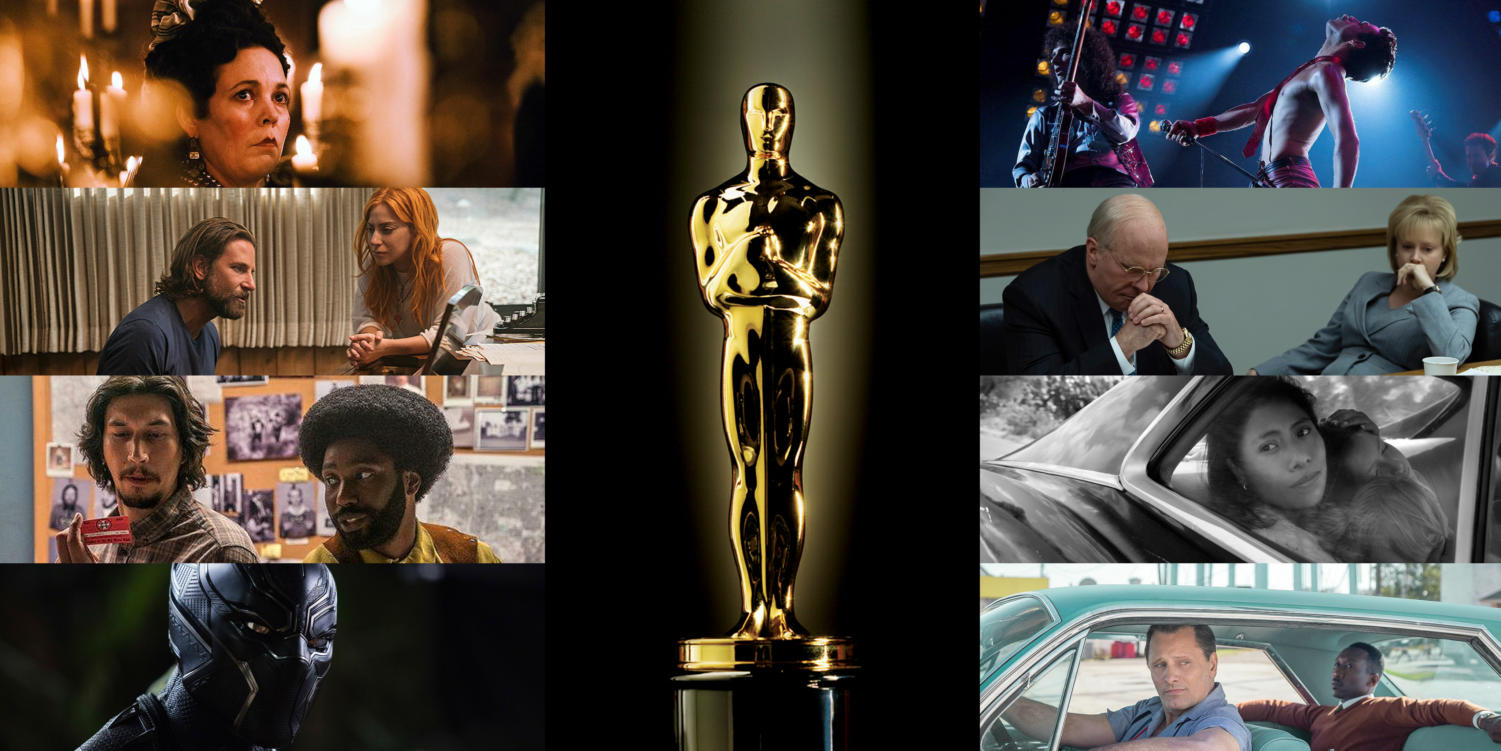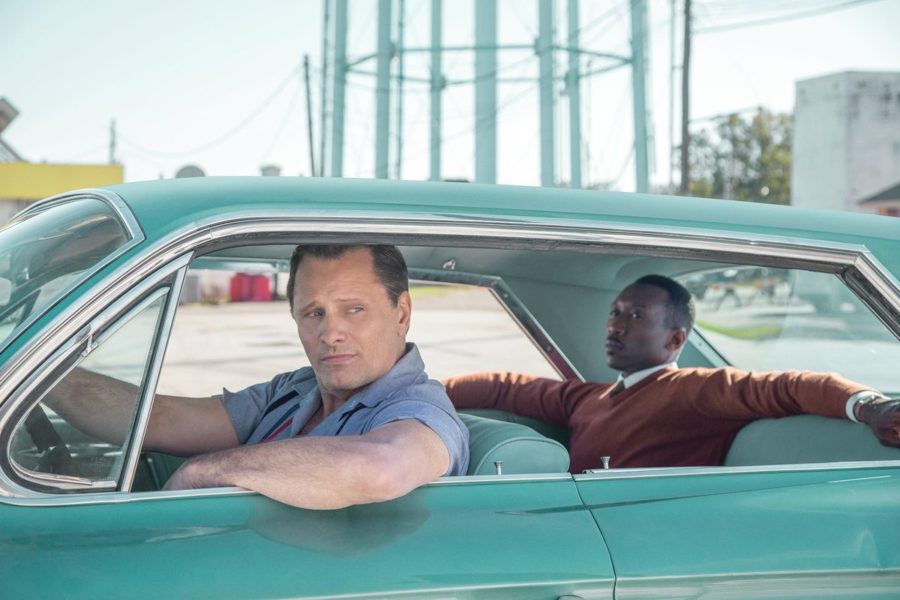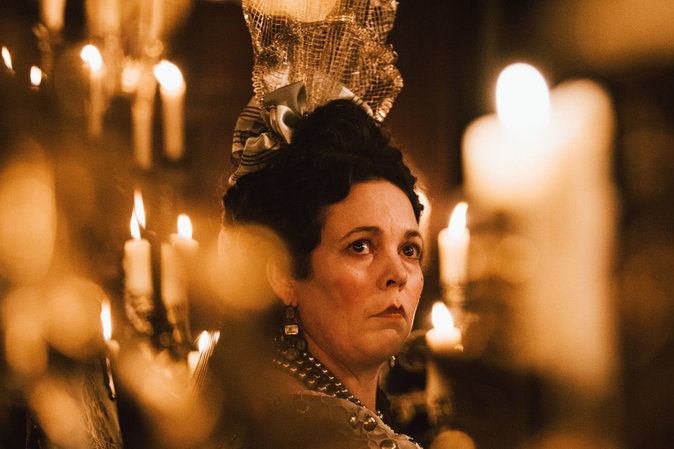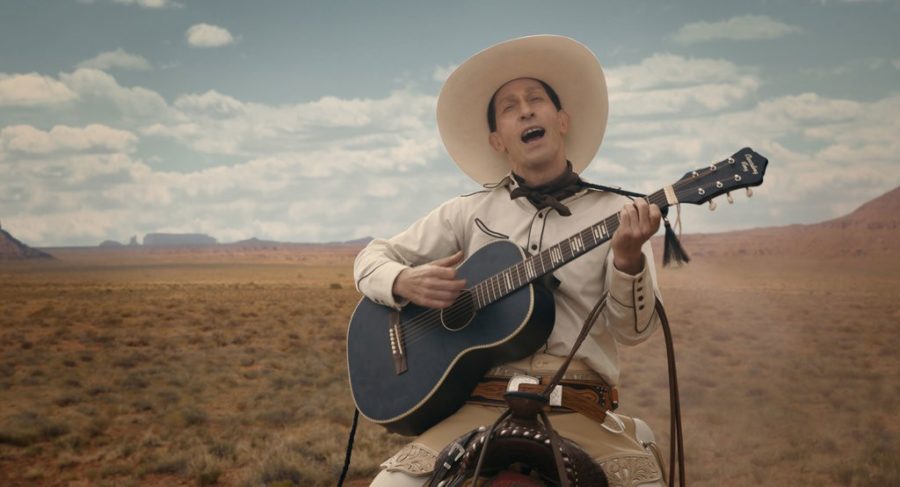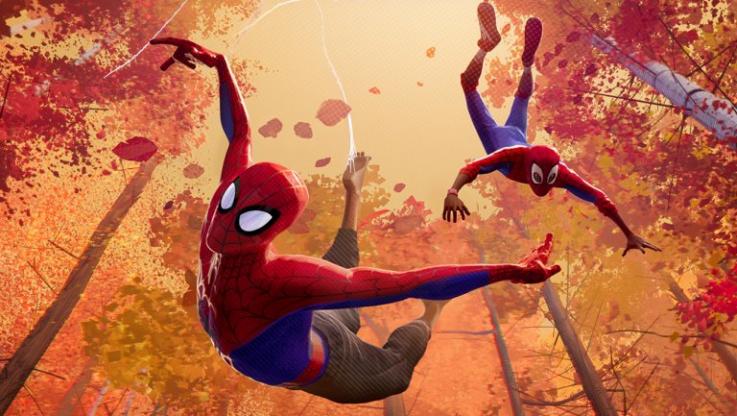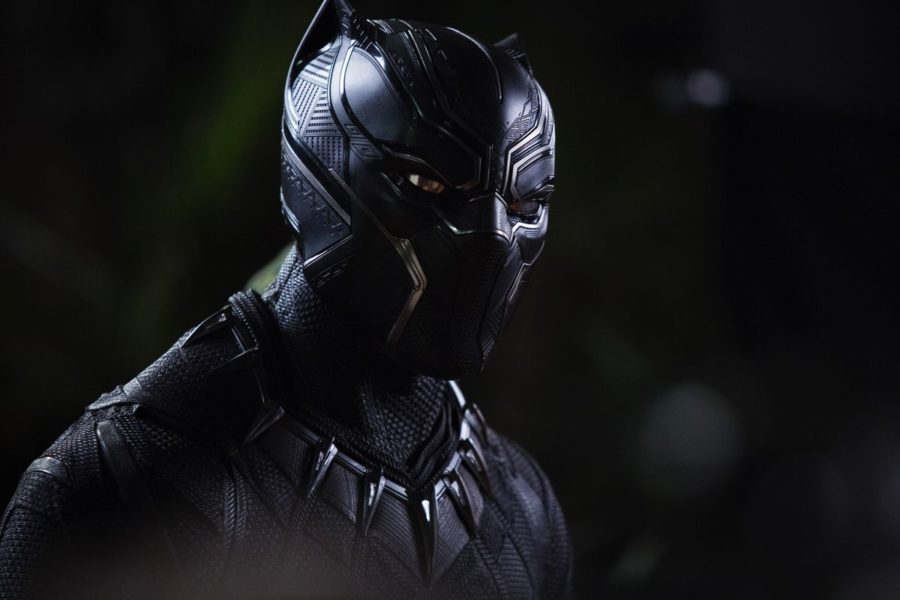Your donation will support the student journalists of Harrisonburg High School. Your contribution will allow us to purchase equipment and cover our annual website hosting costs.
Popular Predictions: A Series
December 20, 2018
Popular Predictions is a series by senior Kevin Pizano and freshman Sam Rooker where the two review films that they believe are worthy of the 2019 award season. Every week, the two will post a review until the big finale: the Oscars.
Patti Perret/Universal Studios
“Green Book” is a crowd-pleasing road trip of a film
Intro
Many films come along the way that are worthy of Best Picture: films that deserve to nominated and Oscar bait films.“Green Book,” is a rare film that draws a line in between both of those categories. Director Peter Farrelly brings his own take on the dramatic genre after a slew of comedy films such as “Dumb and Dumber,” and “There’s Something About Mary.” Farrelly’s brilliant direction balances humor and subtle, dramatic scenes into the buddy duo story. “Green Book” is a film that manages to be charismatic and offers a very surface level message on racism that appeals to nearly everyone.
Synopsis
The story takes place in 1962, a time of racial division and a lack of a GPS in sight. Frank “Tony Lip” Vallelonga (Viggo Mortensen), an Italian bouncer is put out of work after the club he works at is in need of renovations. Mortensen plays his character as a larger-than-life persona that can be a delight to watch, even if his character can be irritating at times. In terms of physical features, Mortensen gained an additional 30 pounds and adopted an Italian accent for his role. Looking for employment, Tony searches for a part-time job that evidently leads him to find work as a chauffeur for the gifted black pianist, Donald Shirley (Mahershala Ali). Shirley cultivates a superior attitude due to his knowledge and musical abilities. This creates him as an easy target for racism and hate from other people including from his own race. Vallelonga and Shirley will find themselves on a eight-week concert journey through the deep south – which means leaving family and trying to survive an array of life-threatening situations. The title is a reference to a The Negro Motorist Green Book, a guide that provided information on available public services for black travelers during a time of Jim Crow and sundown laws.
A unique viewpoint on one’s culture
The most interesting aspect of “Green Book” is Shirley’s viewpoint of the world that he has come to embrace as his reality. On the way to North Carolina, Shirley gazes off to a wide plain filled with black laborer picking up cotton. Their sweat-soaked faces reflect an expression of astonishment and wonder as they have never seen a black man sporting a suit before. Shirley floats through the world as a individual at odds with mainstream African-American culture. Audiences do not often see the point of view of someone not personally connected with their own roots. Hence the fact, Vallelonga states “I’m more blacker than you!” because of Shirley’s lack of knowledge on black musicians such as Aretha Franklin.
A charming buddy-duo chemistry
Mortensen and Ali are marvelous to watch as they play off each other in unfriendly territory. “Green Book” puts the two in a turquoise cadillac, which creates for a chamber of heart, soul and humor. Farrelly utilizes them as a way to contrast their differences and provide commentary on racial barriers. In an initial scene, Vallelonga puts glasses drunk by two black workers in the trash can. The story turns into a silent walk of redemption for Vallelonga’s ignorance and Shirley’s snobbish view on his culture. As audience members, we already know Tony will connect with the harsh reality that blacks face and Donald will open himself up to his culture and driving companion.
A lack of depth on racism
“Green Book” takes a conventional route towards racism, rather than a confrontational way that is seen in films such as Blackkklansman. My biggest problem with the film is how safe it addresses the topic of racism. The film takes a direction that does not challenge the audience on racial issues. This could have added more depth to Shirley’s experiences as a black man and Vallelonga learning how awful racism is. Many people will not have an issue about this aspect of the film, but it could have benefited the film’s experience considering how complex Shirley’s character is.
Wrap Up
The film is a relevant film that addresses racism in a serviceable way. I would personally say it is worth the price of admission just to see Mortensen and Ali’s incredible chemistry with one another. “Green Book” may not be the strongest film contender to discuss racism this year, however it manages to hammer a subtle reminder of the racial issues of today.
Alex Bailey/Twentieth Century Fox
Battle of the Biopics
Intro
The role of a biopic is to tell a living person’s story, whether it be a specific moment in time of a life or the entire arc of a life. Biopics risk the ability to be elevated to truly great films because they can be so limited by what came before. They can be constrained by actual history as much as the tropes of the genre. Three biopics were released in the 2018 awards season that have been recognized and nominated for the awards season: Vice, Stan and Ollie, and Bohemian Rhapsody. The three are each great films in their own respect, but they are all very different films in their approach to the biopic genre. Furthermore, with this review I’m going to look at how each of these films works to tell these peoples stories.
Synopsis
Vice follows Dick Cheney (Christian Bale), as he goes from a lowly intern to America’s most powerful Vice President. It shows his personal struggle as he is torn between his corrupt political life and his family. It’s a stunning tale of one man’s career that is told in a fresh and interesting way. It provides dark and terrifying humor that you don’t want to laugh at but do anyway. If Vice is the dark and gritty biopic of the three, then Stan and Ollie is the polar opposite. The film tells the story of vaudeville comedians Stan Laurel (Steve Coogan) and Oliver Hardy (John C. Reilly) as they go out on stage for one last tour. Complications quickly arise though as the two realize that they have little time left together and must come clean about the lies they’ve told. It’s a truly charming and funny story that will provide laughs for all ages. Bohemian Rhapsody takes a look into the complicated life of the lead singer of Queen, Freddie Mercury (Rami Malek). It shows the bands rise to fame and the clashes they have as they feel more and more distanced from Mercury. It shows his growth as a musician and as a person when he realizes that the people in his life are more important than his career.
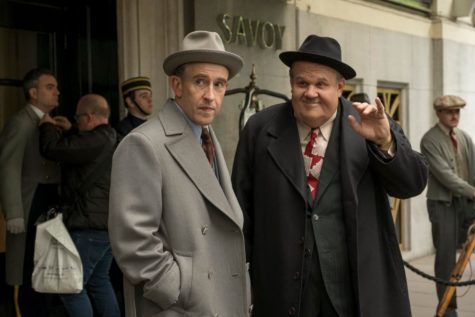
Arcs as Art
Arguably the most important factor of a biopic is the character arcs, or the way they progress through the film. No life is static; our emotions are roller coasters in perpetual motion and the historical figures on film must reflect that. All of the main characters in these films have complex and broad arcs that change throughout the film. At first in Vice we see that Dick Cheney keeps his private life separate from his political life, and his moral compass is his family driven directly by his wife. At the end of the film we see that Cheney has changed and lost his heart when he burns bridges with his friends and family, finally accepting that he can only allow room for his ambitions. In Stan and Ollie, we see the evolution of the relationship between two old friends as they realize how much fun they’ve had in their career and rescue their friendship. When Bohemian Rhapsody starts, Freddie Mercury is a naive and confused young man who values popularity more than his relationships. Mercury slowly realizes that he must reevaluate his priorities when he finds himself alone and diagnosed with AIDS. The arcs in all these films illustrate complex characters that grow and evolve over their runtimes.
Stylistic Choices
It’s essential with all of the characters in these films to show them as people, and show the contexts they lived in. Each of these films decided to use different stylistic elements. Bohemian Rhapsody uses spectacle to convey the larger-than-life quality Freddie’s celebrity had. Stan and Ollie illustrates their late life lives to show that their comedy came from their relationship. In my opinion Vice is the most stylized of the three. It uses imagery and dark humor with stylized editing that creates a growing sense of unease. The reasons for this choice, as the filmmakers explain at the beginning of the film, was because of how secretive Cheney was. The plot requires these dramatic elements to fill in for the pieces of his life that still haven’t been explained. Each of these elements work to create films that set themselves apart from the biopic genre and they are interesting and fresh films that don’t feel pressured into falling into preconceived tropes.
Great Performances
In order to make a great biopic you need the actors playing your leads to deliver great performances. Every one of the actors playing the leads in these films are believable. One performance that stands out is Rami Malek as Freddie Mercury. Malek has figured out how Mercury moves and sings. Christian Bale also delivered a masterful performance as America’s most diabolical Vice President. His portrayal of Cheney is creepy in a contained manner as we see him dismantle the very country that voted him into office. Even Steve Coogan was great as Stan Laurel. He shows a man needing to change with the times who is losing his best friend, his career, and realizing there is no Laurel without Hardy.
The Role of The Biopic
Most people only know these people by their depictions in popular culture. A biopic is not a documentary where the runtime is purely made up of facts. Biopics are probably the most influential medium when it comes to how people view popular figures in culture because they fill in details that history books may not provide. As a culture, we are the end users who remember these people. That’s the ultimate power of the cinema; it’s a great machine that is universal across languages, gender, race and orientation so everyone can understand the real people they are viewing on screen. The legacies of Dick Cheney, Stan Laurel, Oliver Hardy and Freddie Mercury are in our hands and we must choose how generations view them.

Wrap Up
So you’re probably saying to yourself, “Sam, which is the best?” Well my ranking would consist of: Vice in first, Stan and Ollie in second and Bohemian Rhapsody in third. This is not an easy thing to rank because all the films are so different and good for different reasons. It’s like comparing oranges and apples. That’s not to say that Bohemian Rhapsody isn’t as good as the other two films, but Vice is just so innovative and Stan and Ollie features seasoned actors giving their all while operating on a shoestring budget. These are all great films, and you should definitely go out and see them, but Vice truly was an original take on a constantly evolving genre that will be discussed in popular culture and film classes for years to come.
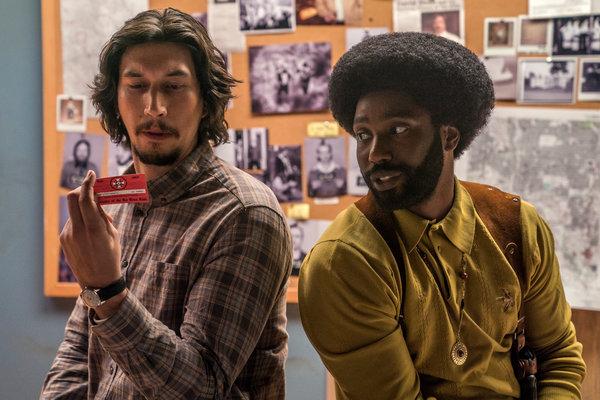
“BlacKkKlansman” delivers a fierce punch to racist American ideals
Intro
Director Spike Lee returns to form with “BlacKkKlansman”, a true yet bizarre story of a black man infiltrating the KKK. Lee takes no time to plunge into his personal beliefs on racism through an opening scene revealing a shot from the film “Gone With the Wind.” He utilizes this as a way to show the history of American racism to set the tone for the duration of the film.
Synopsis
The film follows afro-sporting Ron Stallworth (John David Washington) who, in the 1970s became the first African American detective in a small-town Colorado police station. After asking for undercover work, he is tasked to attend a Black Panther rally in order to infiltrate a civil rights leader. At the rally, he meets Patricia Dumas (Laura Harrier), president of a black student union at a college, and begins to find an interest for her. A date ensues after the rally, but an incident with a racist patrolman leads to his reassignment to the intelligence division. He comes across a newspaper to find an advertisement about becoming a member of the KKK. From there, Stallworth poses as a white man on the phone and recruits Jewish colleague Finn Zimmerman (Adam Driver) to act as him in order to infiltrate the KKK.
Washington’s and Driver’s buddy-cop chemistry
Ron and Flip’s friendship make for a entertaining duo of characters, which is only elevated by the dark, humorous script. Washington and Driver deliver solid performances as their characters find themselves in nail-biting situations with members of the KKK. Stallworth develops annual phone conversations with the Grand Wizard, David Duke (Topher Grace), while still posing as a racist, white man. Grace plays David Duke with a sense of unnerving sense of charisma, even though the audience is aware of the hateful ideology that his character follows in.
Lee’s politically charged direction
Similar to Lee’s production of previous films, he smartly hides a reflection of our modern society within his films to get his point across. During one scene, Stallworth expresses his thoughts on how a man like David Duke could get elected as president of the United States. Ironically, a white cop states his thoughts as naive. However, today’s audiences are understanding of the joke because a man endorsed by Duke has indeed taken the presidency.
“BlacKkKlansman” manages to be an wildly entertaining film, despite the dark subject matter. Through Lee’s direction, he masterfully crafts for a series of unpredictable events. The tonal shifts within the story can be jarring at times – from playful and humorous to morbid and horrific- and certain characters are written for humorous effect, which can take you out of the film. Above it all, the layers in the film are effective in showing audiences a closer view of their own world, which I presume was Lee’s intention.
Wrap Up
Even though the nature of the film’s real events are exaggerated for dramatic effect, Lee understands his intentions to try and confront audiences with a reality that many refuse to see. “BlacKkKlansman” is a necessary piece of cinema that calls for change and concludes on a grim note that the events in the film still paint a portrait of America today.
Atsushi Nishijima/Fox Searchlight
Olivia Coleman plays Queen Anne in “The Favorite.” Pizano believes her portrayal was one of the best female performances of the year.
‘The Favourite’ provides wonderfully wicked period drama
Synopsis
“The Favourite” is a twisted tale of lust, manipulation and ambition between 18th century lovers. Director Yorgos Lanthimos creates an extravagant period piece filled with dark humor and powerful performances. Set in 18th century England, Queen Anne’s world is changed when her right-hand woman, Sarah Churchill’s (Rachel Weisz) younger cousin Abigail Hill (Emma Stone), arrives looking for work. Things go awry when Abigail discovers how close the queen and her duchess really are. A conflict arises as Abigail and Sarah climb to be among the queen’s favorite, leading to a battle of the wits between the two.
A trio of grand performances
The fierce trio of women shine in performances worthy of award recognition, with Olivia Colman as Queen Anne being one of the best (and my favorite) female performances of the year. Her acting prevails as humorous and at times heart-wrenching. Whether it be screeching at the top of her lungs towards a servant or a long take of her facial expression showing jealousy, she always finds ways of expressing her performance range. Despite her actions being seen as humorous or over dramatic, she is later found to have a heartbreaking backstory (involving her seventeen rabbits) that shifts the story to a tragicomedy. Sarah’s character is driven by being frighteningly authoritative and is practically the ruler of the country, as Queen Anne is a frail leader. Abigail serves as a maid, however she quickly climbs the social ladder through her charismatic and manipulative ways toward the queen. The high-school type of drama between Churchill and Hill is nothing short of entertaining with their scenes plagued with tension and strong dialogue. Viewers will soon realize there is no one to root for within “The Favourite,” but that’s exactly why it’s such an entertaining experience to witness.
Technically marvelous period-piece film making
Lanthimos continues his trend of making his films as deeply weird and original as possible. There are duck races, seventeen rabbits hopping around the kingdom and a memorable ball sequence filled with absurd dancing. As Lanthimos is known for many eccentric film projects, “The Favourite” serves as the most mainstream film to date that is easily understood. The script blends dark wit and riveting drama together in such a skillfully constructed and original way. Three-time Oscar winner Sandy Powell decorates the cast with lavish costumes and powdered wigs, easily being the best costumed film of the year. Cinematographer Robbie Ryan shot the film similar to a Rembrandt painting, which has not been seen since Kubrick’s “Barry Lyndon.” Among the many technical aspects, my biggest complaint was the use of the fisheye lens for specific scenes of the film. I understand the directors intended purpose for the photography, however it bothered my viewing of an already gorgeous film to look at. Likewise, people who are not fond of period dramas, I would highly recommend viewing this engaging black comedy that is sure to reign as a favorite across the award season.
“The Ballad of Buster Scruggs” is an original take on a classic genre
Intro
Netflix has had a rocky track record with the success of its original films with works like “Bird Box” and “Bright” falling short of expectations. This in addition to the intense doubt surrounding the possibility that any of their original content will ever be nominated for an award because of their “made for TV” status, has meant that netflix’s chances of nabbing an award were slim. Then, at last, Netflix pinned down a fantastic directing pair, the Coen brothers (Joel & Ethan Coen), to provide a new concept that was might change the perception of netflix’s original films. “The Ballad of Buster Scruggs” is the western love child that was born out of this situation. It’s a film that challenges viewers preconceived notions about what westerns should be, while still being loyal to the format that it’s creators were inspired by. It’s certainly a new face for Netflix, but is it award worthy?
Synopsis
“The Ballad of Buster Scruggs” is composed of six vinyets, set during western expansion after the Civil War. The first vignette, called “The Ballad of Buster Scruggs”, stars a white clad title character (Tim Blake Nelson) who travels the west singing songs and performing general deeds of badassery.
The second vignette, tited “Near Alondages”, is about a lone cowboy (James Franco) who attempts to rob a bank (with a hilarious cameo here), gets caught and is about to be hanged, but is saved by a passing cattle rustler. Unfortunately he is once again caught and is ultimately killed.
The third story, titled “Meal Ticket”, is about an old struggling manager (Liam Neeson) and his innocent quad-amputee performer (Harry Melling). It chronicles their struggle to survive while providing rare moments of beauty and how in the end, survival is more important.
The fourth vinyet is called “All Gold Canyon”, about a lone prospector (Tom Waits) who is on a mission to find gold in a beautiful forest canyon. He finds the vein, is claim-jumped, escapes death, and rides of into the sunset.
The fifth vinyet, “The Girl Who Got Rattled”, follows a young woman, Alice Longabaugh (Zoe Kazan) trying to survive by herself on a long Oregon wagon train ride. Alice succumbs to her fears in a tense moment and it is her end.
The sixth and final vignette is titled: “The Mortal Remains”, about five travelers in a darkening coach, driven by a mysterious driver who will not stop. They talk about their travels, but are oddly unaware of why they are together. The passengers on the left of the carriage (Tyne Daly,Saul Rubinek,Chelcie Ross) become more and more suspicious of the two undertakers on the right of the carriage. When they reach their gloomy destination they enter with cautious, bewildered expressions and credits roll as western music plays.
Directing
With over 20 films under their belt, the Coen Brothers are seasoned directors. With every film they make they add to the perverse drama and humor that subverts your every expectation. Their choice in this film to favor aesthetic beauty over spectacle is in the style of their other films like “The Big Lebowski” or “Oh brother, Where Art Thou”. “The Ballad of Buster Scruggs” is the perfect format for their style because of how well known the western genre is. The first films that often come to mind when you mention westerns are classics like “The Magnificent Seven” or “The Good, The Bad, and The Ugly”. However, The Coen brothers introduce hilarious comedy that will make you laugh out loud when something happens as you least expect it. They can also pull on your heart strings with an unexpected death that shocks, or a twist ending makes you question the whole set up and it’s complex themes. The mark of a great director is the ability to use tone in different and purposeful ways, and the Coen brothers have obviously nailed that in this film.
Writing
The central idea behind “The Ballad of Buster Scruggs” is the concept of death as a constant element in western expansion, and life. A book of western tales any kid might read is introduced at the start and provides the structure for the stories. The Coen brothers are auteurs in every step of their creation process, borrowing from previously written material as well as their own stories. The characters are so well fleshed out that the sketches, while short, don’t feel incomplete. The writing can swerve from silly to severe in a deft manner that doesn’t feel out of place in the rest of the film. Other modern westerns tend to focus on the politics and ethics of expansion, but the film is something totally new in it’s writing style. The conversations between characters are expertly tailored to fit the relationships and the surprises don’t feel weird.
Performances
Every performance in “The Ballad of Buster Scruggs” is terrific. With high caliber talent like Liam Neeson and Tom Waits, there is a lot to expect from the acting. I thought that Tim Blake Nelson’s performance as Buster Scruggs was hilarious. The swagger and charisma of a banty rooster that he brought to the character made him a highlight of the whole film. Liam Neeson and Harry Melling allow you to empathize with a showman so desperate to eat that he would murder his partner using only a few lines the entire story. James Franco’s carefree attitude through everything (even his impending death) is funny and even more surprising when he is recaptured and put to death. Tom Waits was charming as the old prospector in “All Gold Canyon”, and the trio of contrasting strangers in “The Mortal Remains” pull out the everyday faults we all have. It makes it hard to pick out a single performance that could be nominated for best actress or best actor.
Wrap Up
The cinematography and the score are also top notch. The film is so fully realized that it makes it difficult to sift through for individual award nominations. But there are several awards that it could be nominated for: “Best Directing”, “Best Original Screenplay”, and “Best FIlm”. But what really makes this film such a masterpiece is the obvious impact that the Coen brothers had on every aspect of the film. They are artists that make sure that their concepts and visions are fully realized in all details of the production. It is the kind of film Netflix has needed for a long time that legitimizes their original films. It is an award worthy film in general, and able to go up against big screen works. I wish it the best of luck in the highly competitive 2019 awards season.
Rooker is confident that with excellent writing and visuals, Spider-Man: Into the Spiderverse has the potential to be recognized with some of the best films of the year as an animated feature.
‘Spider-Man: Into The Spider-Verse’ is best animated film in long time
Intro
2018 was a great year for films. However, there was one film that pushed the boundaries of what film is capable of: “Spider-Man: Into The Spider-Verse”. Most of you are probably thinking to yourself: “Sam, really, an animated film? Isn’t that some kind of kids movie? You probably just picked it because you’re a comic book fan.” Into the Spider-Verse is so much more than just another comic book movie, it’s a beautiful work of art that totally changes preconceived notions of what an animated film should be, and that makes it the best film of 2018. There were several factors that went into my pick and if you want to know why, not only do you need to see this cinematic masterpiece, but I urge you to keep reading.
Synopsis
Into the Spider-Verse follows Miles Morales (Shameik Moore), who is a high school student that was recently accepted into an elite boarding school. As Miles is walking to his new school and greeting his friends, Miles’ Dad (Brian Tyree Henry) picks him up in his police cruiser when Miles falls down on the pavement. On Miles’ drive to school we can see on surrounding screens and newspapers that there is a resident Spider-Man (Chris Pine) in Miles’ universe. After an embarrassing confrontation with his dad, Miles goes to each of his classes and starts to get bogged down with all the work he has to do. After school, he meets up with his uncle Aron (Mahershala Ali), who is the person that Miles connects with the most, and he finds ways of spending time with him. They go to a abandoned subway tunnel where Miles puts up his graffiti. During this scene Miles is walking out, and a radioactive Alchemex spider bites him. We see the venom of the spider course through Miles’ veins as he slaps off the spider off with a grunt.
Miles begins to experience weird things. He goes to confront a girl he met the previous day, Gwen Stacy (Hailee Steinfeld), but when he talks to her his hand sticks to her hair and the nurse is forced to cut Gwen’s hair. Through more embarrassing events, we see that Miles has obtained the same powers that Spider-Man has. That night he ventures back to the tunnel where the spider was, but when he starts to look for the insect, he hears strange noises and ventures further into the tunnels. He comes to an enormous structure made of hexagonal white tiles, and just as he is about to venture into the tunnel the gargantuan Green Goblin (Jorma Taccone) busts out of it chased by Spider Man. After a back and forth between Miles and Spider-Man, Spider-Man tells Miles he needs to shut down the “Super Collider.” We are introduced to the mafia crime lord, Kingpin (Liev Schreiber), when he makes the call to turn on the machine from his viewing box in the wall of the Collider. Several universes open and we see that different parts of New York morph and change in ways that are reminiscent of the art styles of the other universes. The test goes wrong and the collider collapses. Miles exits the rubble and sees a dying Spider-Man lying on a stack of rubble. Spider-Man tells Miles that he needs to shut down the supercollider in order to save New York and hands him a U.S.B stick that has a code to shutdown the machine.
The rest of the film chronicles Miles’ path to becoming his own Spider-Man and shutting down the Super Collider. He joins forces with Spider-Gwen, alternate reality Spider-Man (Jake Johnson), Spider-Man Noir (Nicholas Cage), Penny Parker (Kimiko Glenn), Peter Porker (John Mulaney) and Aunt May (Lily Tomlin) in order to take down Kingpin and his mischievous henchmen. There are twists and turns along the way that surprised me every time, and there were multiple moments that gave me chills when they came up on screen. The visuals are paired with an original hip hop score, and the song “What’s Up Danger?” is perfect for a series of shots showing Miles coming into his own.
Artistic Style
The visual style is beautiful in a way that is difficult to describe. Every frame feels like reading a comic book with interesting new spins on classic characters. Never once did I find the experience cheap or inconsistent, and because of this, I think it truly works. I smiled to myself when a specific sound would play in the audio and text bubbles would come up on screen that mimics the sound being played. There were small details such as different frames being totally made up Halftone dots that added to the immersion of the film. I loved the fact that every Spider-Man was drawn in a different art style that made each one feel like a unique and fully realized character from a different dimension. Spider-Man Noir is done in a black and white Noir, Penny Parkers Spider-Man is drawn like an anime. Spider Ham is drawn like classical animation and Miles Morales, alternate reality Peter Parker and Spider Gwen are drawn in a contemporary comic book style. However, the animators never sacrifice the human element of character for style over substance, which holds the film together.
Writing
Into the Spider-Verse has excellent writing as well as visuals, and that factor ultimately makes it the best film of 2018. There is so much care put into every character in the film and plot, always from Miles’ point of view. Phil Lord and Rodney Rothman knew the characters they were writing thoroughly. Every character in the film changes or evolves. Miles Morales realizes that he can’t be like his universe Spider-Man, he has to figure out what it means for him to wear the mask. Alternate reality Peter Parker mentors Miles through the toughest parts of becoming a hero, and learns that he is ready to be a father in addition to being a better Spider-Man. Gwen Stacy learns that in she needs to let go of her guilt over Peter Parker’s death and let people back in to her life. Spider-Man Noir realizes that the his universe doesn’t have to view the world in black and white, but rather that it is full of unseen colors. Penny Parker realizes that in order to become a better spider person she needs to let go of her father. Even the main villain of the film, Kingpin, realized that he will never get his family back and ends up losing his humanity as a result. I’m so glad they made sure each character had a complete arc, because otherwise the plot would have felt weak and lifeless.
Wrap Up
Ultimately, Into the Spider-Verse is an experience. All great films are experiences because film is at its best when you are taken out of your current situation, you empathize with the characters and lose yourself in a different reality for a while. In the words of the great film expert and reviewer Roger Ebert, “If a movie is really working, you forget for two hours your Social Security number and where you car is parked. You are having a vicarious experience. You are identifying, in one way or another, with the people on screen.” There is something for everyone in Into the Spider-Verse. As we are told in the end. “Anyone can wear the mask.” This film sets a new bar for comic book films, and we can expect so much more out of the genre.
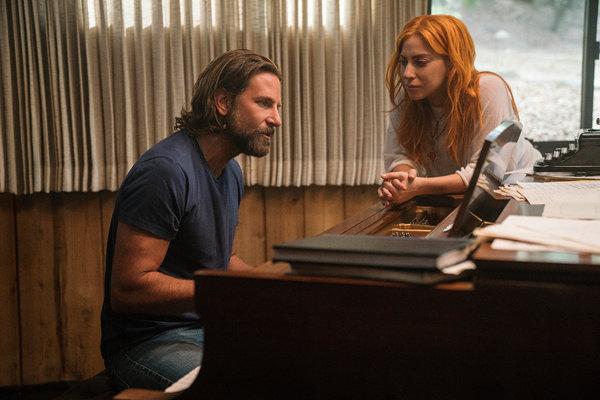
For Pizano, the refreshing romance , incredible supporting cast, memorable soundtrack and meaningful cinematography all contribute to the movie’s potential to win Best Picture.
‘A Star is Born’ reincarnates beautiful, emotional romance
Intro
The fourth time’s the charm with another remake of the classic Hollywood story “A Star is Born”. The film serves as the directorial debut of Bradley Cooper, but it also shines a spotlight on pop star Lady Gaga in her biggest film role to date. Cooper’s new take on the complex and romantic tale of two struggling artists is ascended to new musical heights in modern style.
Cooper and Gaga create magic
Our first introduction to country-rockstar Jackson Maine (Bradley Cooper) is within the first frames of the film at a booming, energized concert scene. In almost an instant, viewers can catch onto his troubling addiction to alcohol and popping pills. This sets into gear the problematic situations that come with being a famous musician. The famed Jackson Maine first meets Ally (Lady Gaga) after a drunken mishap leads him to a drag bar. Ally appears as a deity within his eyes, as she sings a rendition of “La Vie En Rose”. When her gaze locks into his, the two instantly connect at the climax of the song. A chemistry blossoms between the two artistic souls.
Lady Gaga’s on-screen presence as Ally was an absolute delight to witness on the big screen. While she is acknowledged for her voice and charismatic personality, the film’s moments filled with anger and vulnerability sell her as a frontrunner for Best Actress at the Oscars. This is not the first time Gaga has received acclaim for her performances as she went on to win awards portraying The Countess on “American Horror Story: Hotel.” Her character is not much of a departure from her pop star persona, but she manages to transform into an artist seeking fame.
Despite romantic cliches being put here and there, Cooper uses them as a director to craft a love story that feels fresh and original. His direction of the pacing could have been vastly improved within the second act of the film where it tends to drag. However, the third act cleans up nicely as it strikes many emotional cords. Cooper nails it as Jackson Maine because of how he provides a solid portrayal of someone dealing with their inner demons. His current career path has drawn comparisons with Cooper to Clint Eastwood, another example of an actor turned director. With potential behind and in front of the camera, he has the ability to receive recognition as one of the most talented people working in Hollywood today.
A strong supporting cast
While the story is centered on Ally and Jack, supporting characters are utilized as important figures within the story. In particular, Bobby Maine (Sam Elliott) offers a scene-stealing performance as the brother and manager of Jack. The two brothers share a distant, but close relationship out of the fact that Jack “stole” his brothers voice. One of the many heart-wrenching scenes, Bobby drives away after his brother confesses a longtime secret. The emotion within his eyes, ready to flood with tears, show the brotherly love shared between one another. Other strong supporting characters worth mentioning are the protective and loving father of Ally (Andrew Dice Clay) and Jack’s close musical companion (Dave Chappelle).
Memorable, award-worthy soundtrack
“A Star is Born,” is lead by the music sung by romantic duo Jack and Ally. From piano ballads to country-rock duets, the film’s music is centered on themes such as love, bonding and struggle. At one point, Jackson encourages Ally to join him on stage as he sings “Shallow”, a song that they wrote together. As he sings the first verse, Ally paces on stage to join him on the next. Nervous at first, her vocals increasingly get louder and transition into an passionate-filled aria. I was left feeling exhilarated during the scene, which was the peak of the film for me. “Shallow,” is almost a guaranteed winner for Best Original Song at the 2019 Oscars. But the soundtrack as a whole offers a wide variety of earworm-inducing songs, such as “Black Eyes” and “Always Remember Us This Way”.
Gorgeous and meaningful cinematography
Facial close-ups and colored silhouettes of our titular characters brings the story to an intimate type of love story. Cinematographer Matthew Libatique filmed the concert sequences in a first-person perspective to create an impression that we were directly witnessing the concert. Libatique perfectly captures the frame of emotional moments that are timed and choreographed at just the right time.
Wrap Up
The story shifts from a dream-like romance to a heavy drama within the next half hour of the film. Ally rises in fame, while Jackson continues to delve towards alcoholic despair. It is the old-fashioned romantic tale that we have all come to know, but with a story that delves into a closer view of a romance struck with flaws. By the last shot of the film, you are left emotionally drained and possibly in need of tissues.
Director Bradley Cooper and actress Lady Gaga are names destined to be heard more as we roll into the next decade. “A Star is Born,” has only garnered momentum as the award season begins and stands as the crowd-pleasing film to beat. Our next review is the only film that stands in the way of “A Star is Born” chances of winning Best Picture at the Oscars. A foreign language film from Netflix, Roma.
Rooker believes Black Panther has the potential to win Best Picture , drawing attention to the lack of diversity that had previously been associated with the awards.
Black Panther stands out as well-crafted, creatively designed film
Intro
The first film that we believe is in the running for best picture: Black Panther. The film stands out in the Marvel Cinematic Universe (MCU) as one of the most well-crafted and creatively designed films. It has already been put alongside other films competing for Best Picture in the 2019 Golden Globes. It stands out as the only comic book film with the most diverse cast out of all the nominated films. It is a game changer in its approach to the tired old superhero storylines, but what makes it award worthy?
Synopsis
The film opens with a beautiful scene depicting the feud between the different tribes in Wakanda and how the Black Panther was born out of this feud. The first scene cuts to Oakland, California in the year 1992. We meet N’Jobu (Sterling K. Brown), an undercover Wakandan spy. He is having a meeting with Zuri, a fellow Wakandan spy, when there is a knock at the door and the person at the door is revealed to be T’Chaka (John Kani) in his Black Panther suit. T’Chaka accuses N’Jobu of assisting the man he was supposed to find, Ulysses Klaue (Andy Serkis). Zuri reveals that he has been spying for T’Chaka ever since their arrival in Oakland. The scene is cut to a well edited action scene where T’Challa (Chadwick Boseman), Black Panther, extracts his past lover Nakia (Lupita Nyong’o) from an undercover assignment and asks her to attend his Coronation ceremony. The Coronation ceremony starts the following day where T’Challa is challenged in combat by old rival, M’Baku (Winston Duke). T’Challa wins and is crowned king of Wakanda. He is given a heart shaped herb in a ceremony that gives him the powers of the Black Panther. Killmonger (Michael B. Jordan) kills Klaue after he is arrested for trying to sell vibranium on the black market. Killmonger takes Klaue’s body to Wakanda where he is greeted by the Wakandan farmers. He reveals his Wakandan branding and Klaue’s dead body and he is taken to T’Challa. Killmonger challenges T’Challa’s claim to the throne as he is the son of T’Chakas brother, N’Jobu. They proceed to repeat the coronation ceremony seen at the beginning of the film, except this time this time Killmonger is the victor.
Filmmaking Techniques
Director Ryan Coogler creates a rich and expansive world that incorporates West African styles into the futuristic design. The care put into the vision of the masterful world building is what makes the film stand out within the MCU. The score by Ludwig Göransson is beautiful in its percussion of heavy instrumentation. Ludwig drew inspiration from the African countries that he had visited. The visual effects are mind-blowing and they seamlessly tie the film together in a way that other Marvel films often do not. There is also another aspect of Black Panthers production that is fantastic and needs to be recognized: the costuming. The costuming in the film is extremely original while still being faithful to the comics and the place where the film is set. The costuming designer, Ruth E. Carter, referenced the Maasai, Himba, Dogon, Basotho, Tuareg, Turkana, Xhosa, Zulu, Suri and Dinka people in her designs. She also examined appropriate works by Japanese fashion designer Issey Miyake. Each design is stunning in a MCU dominated by boring character designs.
Crafting The Perfect Villain
A great antagonist requires a connection to the protagonist in order to make them have a well-crafted conflict. Killmonger is the neglected ruler who feels as though Wakanda has betrayed him in almost every way, including T’Chakas murder of his father. T’Challa feels as though Wakanda has always been there for him, even through the death of his father. Killmonger believes Wakanda will never support him, so he must fight to obtain the throne. Seeing T’Challa as the golden boy enrages him. This creates a bond because of the fact that they are both cousins, but also fighting for the throne. The antagonist must have more power than the protagonist for most of the story. Where T’Challa is calm and composed for most of the film, Killmonger is erratic and untamed in the way he uses his power. Killmonger is always one step ahead of T’Challa, and while his technology might not be more advanced, he is most definitely T’Challa’s rival in hand to hand combat. Tragedy on both the side of the protagonist and the antagonist make for better characters during a conflict. After the death of his father, T’Challa is still raw with rage, but Killmonger has channeled his rage into his focus on obtaining the mantle of king. Because they both share similarities with each other, they make such excellent foils for one another, but their similarities and unseen bonds are what shape them into well-rounded characters.
Cultural Impact
Awards shows like the Golden Globes and the Oscars have come under scrutiny recently due to the lack of diversity in their nominees. People in the industry are constantly commenting things like, “We need a wider variety of nominees” and, “Why is it that only white filmmakers are nominated?”. Black Panther has the power to change the award industry forever if it wins the award for Best Picture. I strongly believe that it will force the Academy to no longer deny their obvious prejudice in their nominee picks because films are essentially a method for telling a story. Only nominating and showcasing a select few views and messages makes for a surefire way to make sure that your award show shrivels up and dies.
Wrap up
I see no reason as to why Black Panther could not rival the other nominees this awards season. It has all the marks of a well-made film with an incredible score, first rate cinematography and oscar worthy performances. Sure, some will say that because it’s a comic book film it has no right to be in the same league as other critically acclaimed films nominated this year. However, I strongly disagree because Black Panther is just as well made, if not better, as these other films. So I wish it the best of luck in this awards season and I hope to see it get the recognition it deserves. Watch out for next week’s review from Pizano and Rooker, A Star is Born.
